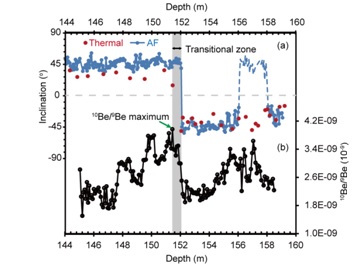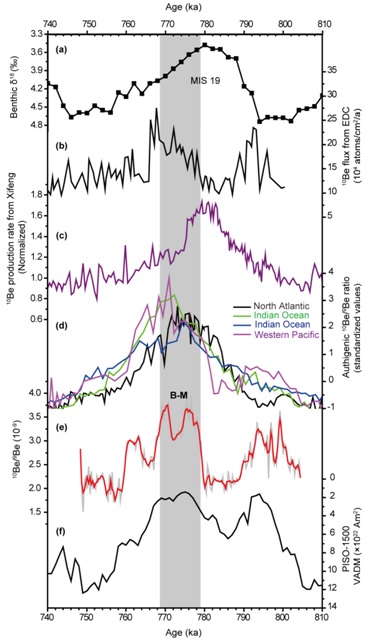The globally averaged 10Be atmospheric production rate is inversely proportional to the geomagnetic dipole moment (GDM). Geomagnetic reversals or excursions are characterized by GDM collapses, so these geomagnetic events can be reconstructed by the 10Be overproduction they trigger, independently of paleomagnetic measurements. The Matuyama-Brunhes (M-B) transition is the most recent geomagnetic field reversal and is an important time marker for the Quaternary period. During the past few decades, this reversal has been investigated by cosmogenic 10Be in many geological archives, including basalts, ice core, marine and lacustrine sediments, as well as Chinese loess. However, there has been no research on tracing M-B reversal using lacustrine 10Be.
Based on the preliminary work on the loess 10Be, the research team led by Prof. ZHOU Weijian from the Institute of Earth Environment, Chinese Academy of Sciences (IEECAS) recently presented a new 10Be record spanning the Matuyama-Brunhes (M-B) reversal from the Heqing paleolake basin in southern China. The aim of this study is the identification of the GDM collapse associated with the M-B transition using 10Be from lacustrine sediments for the first time. Through test and analysis of high resolution 10Be, 9Be data and related proxies, authigenic 10Be/9Be ratio was considered as the most reliable proxy for reconstructing atmospheric 10Be production rates. The M-B transition is identified as a pronounced maximum of authigenic 10Be/9Be ratio between 768.6-778.5 ka, that is consistent with all other available 10Be-proxy records from marine, ice and loess archives. However, it is offset by approximately 0-60 cm depth from the magnetic signature of the polarity transition recorded in the same sediments. This offset is attributed to the lock-in effect of the remanence acquisition process, which is similar to the phenomenon that exists in marine sediments. It is suggested that the identification of geomagnetic reversal/excursion events using 10Be along with paleomagnetic measurements in marine and stable lacustrine sediments (homogeneous clay and silty clay) can help to eliminate the depth offset due to the lock-in effect and obtain more precise geochronologies.
This work has been published on the Quaternary Science Reviews.

Fig. 1.Comparison of 10Be/9Be ratios and paleomagnetic data from the Heqing sediments. (Image by Du et.al)

Fig. 2 Comparison of 10Be production rates and relative paleointensities between the Heqing core and other sediments. (Image by Du et.al)
Contact: Bai Jie, Institute of Earth Environment, Chinese Academy of Sciences, Xi'an, China. Email:baijie@ieecas.cn
 © 2015 Institute of Earth Environment,CAS
© 2015 Institute of Earth Environment,CAS Address:No. 97 Yanxiang Road, Xi'an 710061, Shaanxi, China

 Location :
Location :